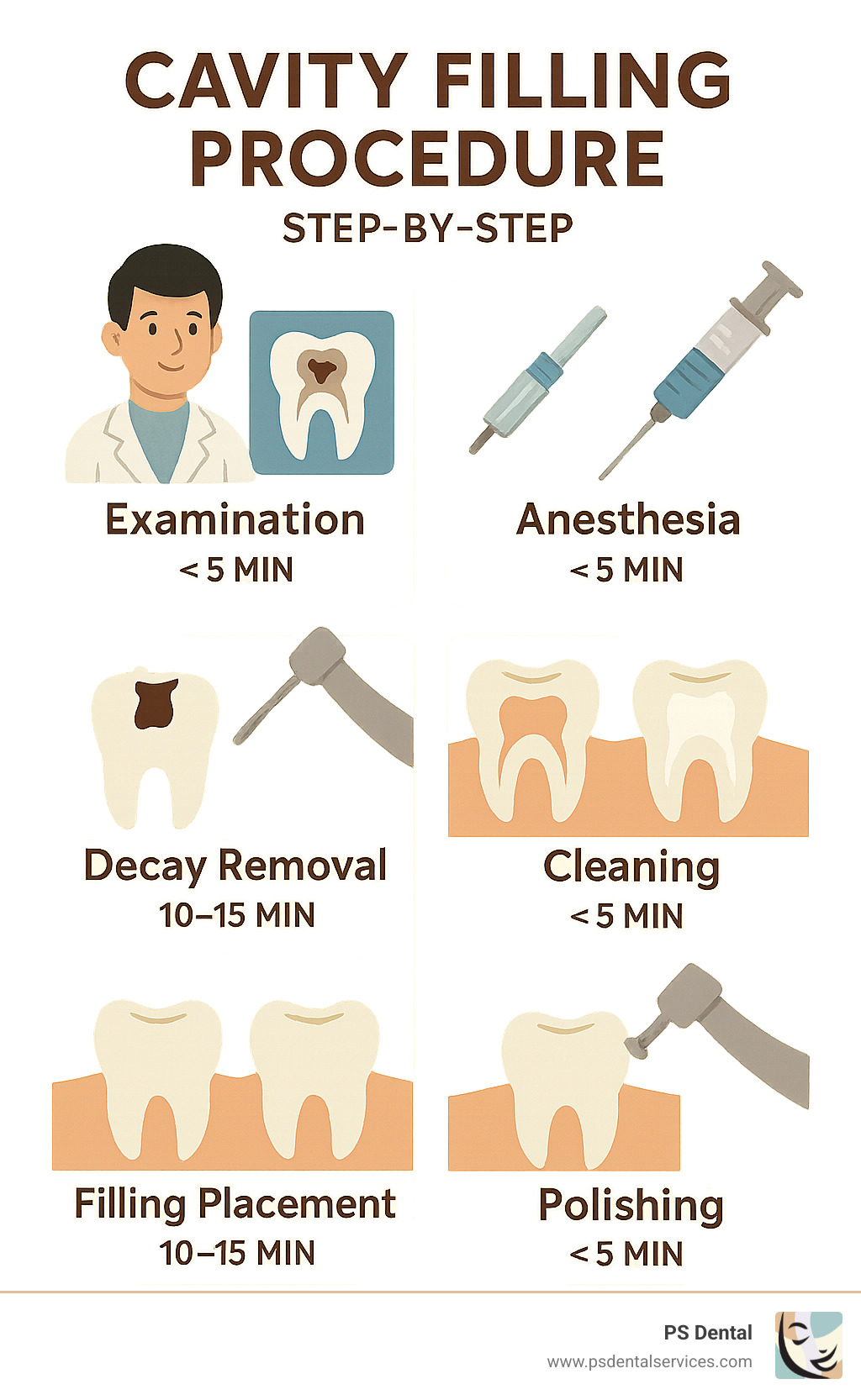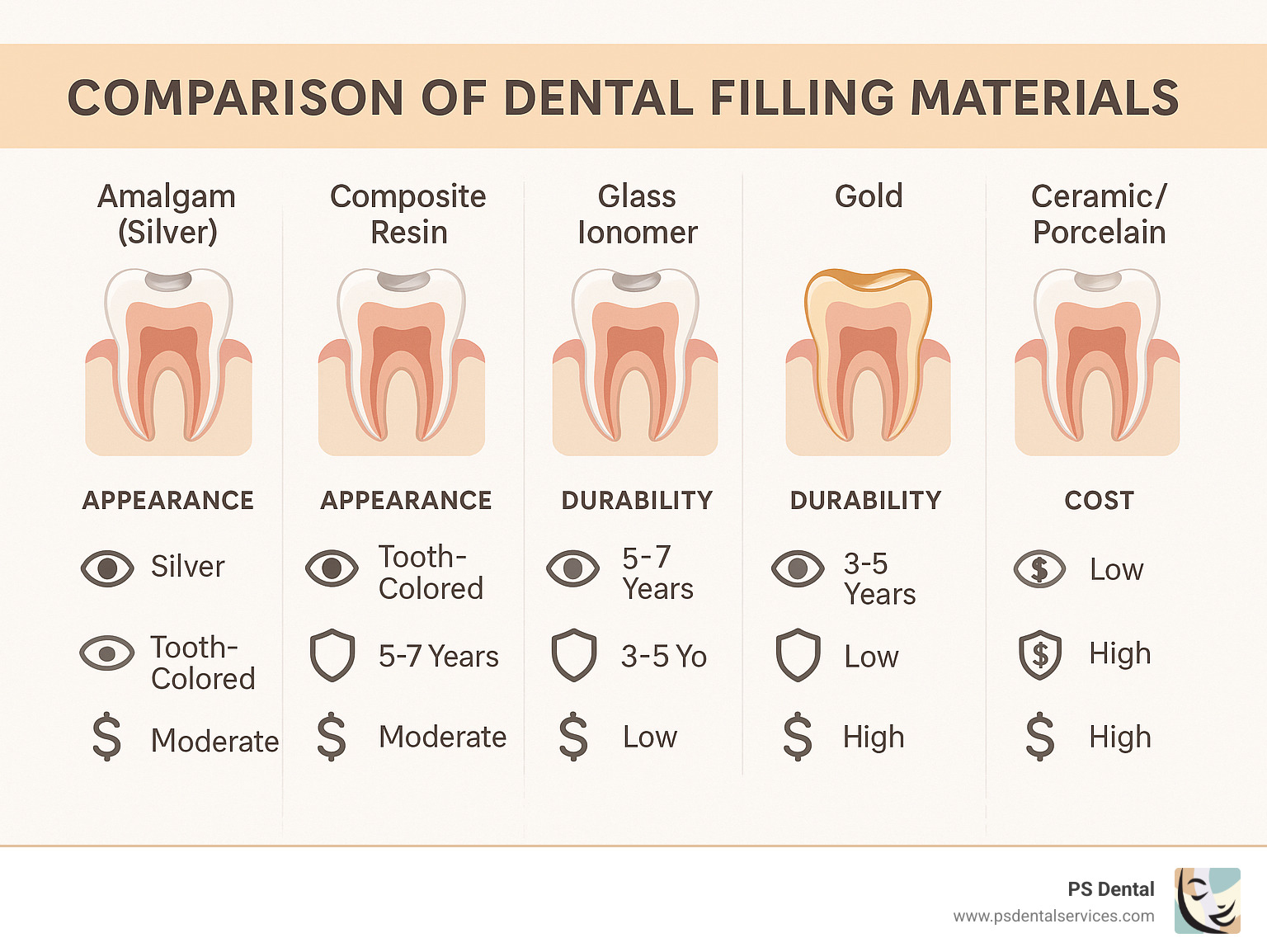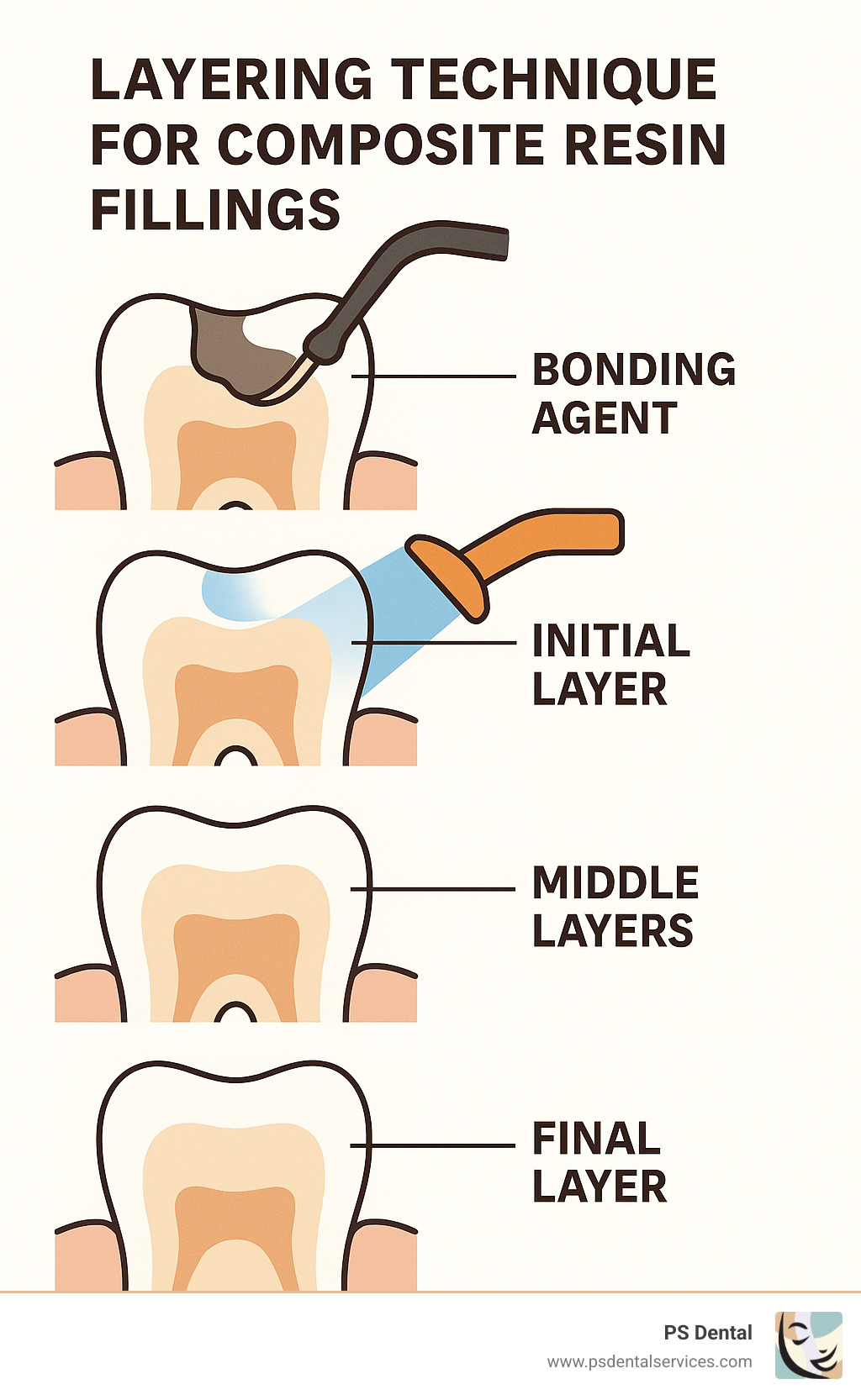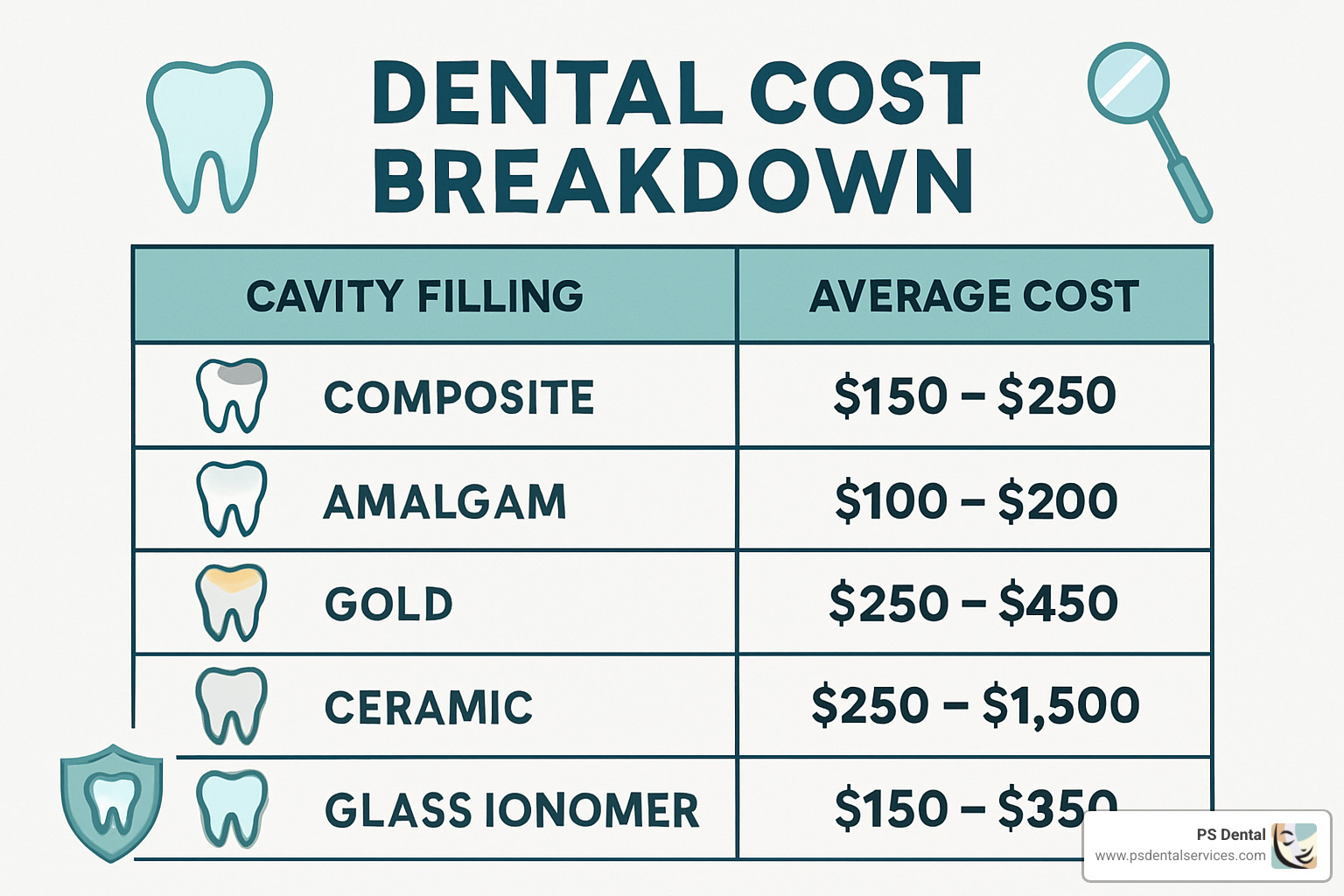Understanding the Cavity Filling Process: What to Expect
A cavity filling procedure is a common dental treatment that repairs tooth decay by removing damaged tooth material and replacing it with a durable filling material. If you’re wondering what happens during this procedure, here’s a quick overview:
The Basic Cavity Filling Procedure:
1. Examination – Dentist examines the cavity using X-rays and dental tools
2. Anesthesia – Local anesthetic is administered to numb the area
3. Decay Removal – Decayed tooth material is removed using a drill or laser
4. Cleaning – The cavity is thoroughly cleaned to remove bacteria
5. Filling Placement – The chosen filling material is applied and shaped
6. Polishing – The filling is polished to ensure proper bite alignment
The thought of getting a cavity filled might make you anxious, but modern dentistry has made this procedure quick, effective, and virtually painless. With approximately 91% of American adults having at least one filling, it’s one of the most common dental procedures performed worldwide.
Tooth decay is one of the most widespread health conditions globally, according to the World Health Organization. Catching and treating cavities early prevents further damage and potentially more complex procedures down the road.
I’m Dr. Parisa Sepehri, and throughout my 30+ years as a dentist, I’ve performed thousands of cavity filling procedures with a focus on patient comfort and using the latest techniques to ensure lasting results. My approach combines technical precision with a gentle touch to make the experience as stress-free as possible.

When Do You Actually Need a Filling?
Do you really need a filling for that tiny spot on your tooth? It’s a common question many patients ask. Understanding when a filling is truly necessary helps you make smart choices about your dental health without unnecessary treatments.
Tooth decay is sneaky – it develops in stages. In the earliest phase, you might notice white spots on your enamel, which is actually your body’s warning system. These spots often can be reversed with diligent brushing, flossing, and fluoride treatments. But once decay breaks through the enamel creating an actual cavity, a filling becomes your best defense.
“Many patients are surprised to learn that early-stage decay can sometimes be reversed without drilling,” explains Dr. Sepehri. “But once a true cavity forms, a cavity filling procedure is the most effective way to prevent further damage and protect the tooth.”
Red Flags You Might Need a Filling
Your teeth have ways of telling you something’s wrong. Pay attention if you experience toothache or pain that flares up when you bite down or enjoy your favorite foods. Sensitivity that lingers after sipping hot coffee or cold drinks often signals decay has reached the deeper layers of your tooth.
Visible holes or pits in your teeth are obvious signs you need professional attention, as are dark spots or discoloration on any tooth surface. If you find food constantly getting trapped between certain teeth or feel rough edges with your tongue, these are nature’s way of telling you something’s amiss. And of course, if a previous filling has cracked or fallen out, you’ll need it replaced promptly.
I remember Maria, who came to our office after ignoring a small dark spot on her molar for months. “It didn’t hurt, so I thought it was fine,” she told us. By the time she visited, the decay had tunneled much deeper than expected. “I wish I’d addressed it sooner when a simpler filling would have sufficed,” she shared after her treatment.
How Dentists Confirm the Problem

At PS Dental Services, we use several sophisticated methods to confirm whether you truly need a filling. During a visual examination and probing, we gently check for soft spots with special dental instruments. Sometimes, we apply a caries-detecting liquid – a special dye that clings to decayed areas, making them stand out.
For areas hidden from view, we rely on digital X-rays that show decay lurking between teeth or beneath existing fillings. These modern X-rays use significantly less radiation than traditional ones, keeping your exposure minimal. We also employ laser cavity detection technology that measures fluorescence within tooth structure, catching decay at its earliest stages. With transillumination, we shine a light through your tooth, revealing decay as darker areas.
Dentists classify cavities into six different classes based on location – from Class I decay in pits and fissures to Class VI decay on incisal edges or cusps. This classification helps us determine the most appropriate approach for your cavity filling procedure.
Can It Ever Be Too Late for a Filling?
Unfortunately, yes. There comes a point when decay has advanced too far for a simple filling to be effective. When decay reaches the inner pulp – the tooth’s living tissue containing nerves and blood vessels – you’ll typically experience significant pain, and a root canal followed by a crown becomes necessary.
You may have progressed beyond the filling stage if you’re experiencing severe, persistent toothache, pain when chewing, prolonged sensitivity to temperature changes, swelling or tenderness in the gums around a tooth, or darkening of the tooth.
“The best time to treat a cavity is as soon as it’s detected,” advises Dr. Sepehri. “Early intervention with a cavity filling procedure is less invasive, less expensive, and preserves more of your natural tooth structure.”
Don’t wait until a small problem becomes a painful emergency. Regular checkups help us catch decay early when treatment is simpler and more comfortable. Your smile is worth protecting!
More info about tooth decay prevention
Choosing the Right Dental Filling Material
When it comes to filling a cavity, one size definitely doesn’t fit all. Different materials shine in different situations, whether you need something super durable for your molars or something that perfectly matches your front teeth. At PS Dental Services, we take the time to help you find the perfect material based on where your cavity is, how it looks, and what works for your budget.
Pros & Cons of Each Material
Let’s walk through your options for filling materials – each has its own special qualities that might make it right for your unique situation.
Amalgam (Silver) Fillings have been workhorses in dentistry for generations. These fillings are incredibly tough and can last 15+ years, making them perfect for those hard-working back teeth. They’re also the most budget-friendly option, typically costing $50-200 with insurance or $200-300 without. The downside? That silvery appearance stands out, especially when you laugh or yawn. They also require removing a bit more tooth structure during the cavity filling procedure.
Composite Resin Fillings are the popular choice for most of our patients today. These tooth-colored fillings blend in beautifully with your natural teeth, making them virtually invisible. They bond directly to your tooth, which means we can preserve more of your natural tooth structure during placement. While not quite as durable as amalgam (typically lasting 5-7 years), many patients feel the aesthetic benefits outweigh this drawback. Expect to pay around $175-250 with insurance or $300-400 without.
Glass Ionomer Fillings have a special superpower – they release fluoride over time, helping prevent future decay around the filling. They’re tooth-colored and work wonderfully for small cavities, especially in non-chewing areas. They’re particularly great for children’s teeth. These typically last 3-5 years and cost $150-200 with insurance or $250-350 without.
Gold Fillings are the marathon runners of dental fillings, often lasting 20+ years or more. They don’t corrode and are surprisingly gentle on the teeth they bite against. The downsides? They’re quite expensive ($500-1,000 with insurance, $1,000-4,500 without) and require multiple visits. And of course, they definitely make a statement with their golden appearance!
Ceramic/Porcelain Fillings offer the best of both worlds – the natural appearance of composite with durability closer to metals. They resist staining better than composite and can last 15+ years. The main drawback is cost, ranging from $300-500 with insurance to $500-1,500 without. They can also be somewhat abrasive to opposing teeth.

“For most of our patients at PS Dental, we recommend composite resin fillings for their excellent balance of aesthetics and durability,” says Dr. Sepehri. “But everyone’s situation is unique – we’ll discuss all your options during your visit so you can make the best choice for your smile.”
Are Amalgam Fillings Safe?
You might have heard concerns about the mercury in amalgam fillings. The American Dental Association and FDA have consistently maintained that amalgam fillings are safe for most people. The mercury in dental amalgam forms a stable alloy with other metals, making it different from the mercury we worry about in the environment.
That said, in 2020, the FDA updated its guidance, suggesting certain groups might want to consider alternatives when possible:
Pregnant women, women planning pregnancy, nursing mothers, young children (especially under six), people with neurological conditions, kidney problems, or known sensitivity to mercury might benefit from choosing mercury-free alternatives.
At PS Dental Services, we’re happy to offer mercury-free options like composite resin for patients with these concerns. Your peace of mind matters to us as much as your dental health.
Special Allergies & Material Sensitivities
Some patients have specific sensitivities that influence filling choices. While true allergies to dental materials are rare, they do happen. I remember one patient who experienced persistent inflammation after receiving an amalgam filling. When we replaced it with a biocompatible composite, her symptoms completely disappeared.
If you have concerns about metal allergies, reactions to BPA in some composites, or sensitivities to components in resin materials, please let us know before your cavity filling procedure. We offer BPA-free composite materials and can recommend alternatives custom to your needs.
“Taking a thorough medical history before any procedure helps us avoid potential sensitivity issues,” explains Dr. Sepehri. “We want your new filling to feel as natural and comfortable as possible from day one.”
When you visit our Tigard office, we’ll discuss all these options in detail, answering any questions you might have about materials, appearance, durability, or cost. Our goal is to find the perfect solution for your unique smile.
More info about tooth color filling
Step-by-Step Cavity Filling Procedure
Ever wonder what actually happens when you’re in the dental chair getting a filling? Let’s pull back the curtain on the cavity filling procedure so you know exactly what to expect when you visit us at PS Dental Services.
Is the cavity filling procedure painful?
I hear this question almost daily, and I’m always happy to reassure patients that modern dentistry has come a long way. With today’s techniques, getting a filling should involve minimal to no pain.
Here’s our approach to keeping you comfortable:
First, we apply a berry-flavored topical gel to numb the surface of your gums. This makes the next step—a small injection of local anesthetic—much more comfortable. Many patients tell me they barely feel the injection after the gel does its work!
For those with dental anxiety (you’re not alone—about 36% of people have some form of dental fear), we offer several comfort options. Nitrous oxide, commonly called laughing gas, can help you feel relaxed while remaining awake. For more significant anxiety, oral sedation medication or even IV sedation for complex cases can make your visit stress-free.
One of our patients, Sarah, recently told me: “I used to reschedule fillings three or four times because I was so nervous. Dr. Sepehri suggested nitrous oxide, and what a difference! I felt calm and even a bit giggly—now I don’t think twice about coming in for treatment.”
During your cavity filling procedure, you’re in control. We establish a simple hand signal system so you can let us know if you need a break or feel any discomfort.
How long does the cavity filling procedure take?
Good news: most fillings are much quicker than people expect! For a single, straightforward filling, you’ll typically spend about 20-60 minutes in our care. The exact timing depends on several factors:
The cavity’s size makes a big difference—smaller cavities are naturally quicker to treat. Location matters too, as back molars with difficult-to-reach surfaces take more time than front teeth. The filling material also affects timing, with tooth-colored composites taking longer because they’re carefully placed in layers.
For most patients, a single filling appointment breaks down like this:
– Getting comfortable and numb: 5-10 minutes
– Removing decay: 5-15 minutes
– Placing your filling: 5-20 minutes
– Checking your bite and polishing: 5-15 minutes
“We respect your busy schedule,” explains Dr. Sepehri. “Many patients are pleasantly surprised they can get back to work or school much sooner than they expected after their cavity filling procedure.”
The Cavity Filling Procedure From Start to Finish
Let me walk you through exactly what happens when you settle into our dental chair for a filling:
We begin by ensuring you’re comfortable and taking any necessary X-rays to get a complete picture of the decay. Once you’re ready, we’ll dry the area and apply that flavored numbing gel I mentioned. After a minute or two, we’ll administer local anesthetic and give it plenty of time to work—usually 5-10 minutes. Many patients use this time to listen to music or a podcast through headphones.
Next comes isolation—keeping the tooth clean and dry during treatment. We might use a small rubber dam (a thin sheet that covers nearby teeth) or cotton rolls and gentle suction. This step prevents moisture and debris from interfering with your filling.
The decay removal phase uses either a traditional dental drill or, in some cases, a dental laser. The sound of the drill is what many patients dislike most, so wear headphones! We work carefully to remove only the decayed portion while preserving as much healthy tooth structure as possible. Sometimes we use a special dye that stains only the decayed areas, ensuring we don’t miss anything.

For tooth-colored fillings (our most popular option), we prepare the cleaned tooth with an acid-etching gel that creates microscopic roughness—think of it as creating tiny “hooks” for the filling to grab onto. After rinsing and drying, we apply a clear bonding agent and harden it with our special curing light.
Now comes the artistic part! We place the composite resin material in careful layers, with each layer hardened with our blue curing light. This layering technique ensures proper hardening throughout the filling and helps create natural-looking results. For amalgam (silver) fillings, we would instead pack the material into the prepared cavity and shape it to match your tooth’s contours.
Once the filling material is in place, we’ll have you bite down on a special colored paper that shows us any high spots. We make precise adjustments so your bite feels completely natural. The final step is polishing your filling to a smooth, glossy finish that feels comfortable against your tongue and resists staining.

Filling a Cavity Between Molars
Cavities between teeth (what dentists call interproximal cavities) require special handling. These spaces can be tricky to reach, but we have specialized tools and techniques to ensure excellent results.
First, we place a thin metal band called a matrix band around your tooth. Think of this as a mini-mold that helps recreate your tooth’s natural shape. We then insert a small wedge between the teeth to create just enough space to work effectively.
Creating the proper contour between teeth is crucial—too tight and you won’t be able to floss; too loose and food will get trapped after meals. We test the contact point with dental floss to ensure it passes through with just the right amount of resistance, mimicking natural teeth.
“Getting these contacts just right is like threading a needle,” Dr. Sepehri often says. “It’s a detail many patients never notice, but it makes all the difference in how your teeth function after a cavity filling procedure.”
One patient, Michael, recently commented: “I had no idea so much precision went into filling a cavity between my back teeth. Dr. Sepehri explained each step, and now I understand why that filling feels so natural when I floss—it’s designed to!”
More info about filling cavity between molars
When you choose PS Dental Services for your cavity filling procedure, you’re not just getting a repair—you’re getting a restoration designed to look, feel, and function like your natural tooth. Our Tigard team takes pride in making this common dental procedure as comfortable and long-lasting as possible.
Recovery, Aftercare & Longevity
Your smile deserves the best care, especially after a cavity filling procedure. The right aftercare not only ensures a smooth recovery but also extends the life of your new filling. Let’s walk through what you can expect and how to keep that filling looking and functioning great for years to come.
What to Expect Right After Treatment
That first day with your new filling has a few quirks to steer. Don’t worry – millions of people go through this every year with great success!
When you leave our office, your mouth will likely remain numb for 1-3 hours. This is completely normal, but it does mean you’ll need to be careful. Many patients accidentally bite their cheek or tongue without realizing it while still numb. Consider it a good excuse to take things easy for a little while!
“I always tell my patients to think of their new filling as needing a short ‘settling in’ period,” says Dr. Sepehri with a smile. “Your tooth just went through quite an experience, and it needs a little time to adjust to its new addition.”

That first day, stick to softer foods like yogurt, mashed potatoes, smoothies, and soups until the numbness completely disappears. Try to chew on the opposite side of your mouth and avoid extremely hot or cold foods and drinks, as your tooth might feel a bit sensitive to temperature changes.
If you’re experiencing mild discomfort, an over-the-counter pain reliever like ibuprofen or acetaminophen usually does the trick. Most patients find they can return to their normal eating habits within 24 hours, though some sensitivity to pressure, air, sweet foods, or temperature might linger for a few days to a week.
One thing to pay attention to is how your bite feels. Your new filling should feel comfortable when you close your mouth. If something feels “off” or too high when you bite down, don’t hesitate to call us for a quick adjustment – this is a simple fix that makes a big difference in your comfort.
Caring for Your Filling Long-Term
Your filling can serve you well for many years with the right care. The good news is that caring for a filling isn’t complicated – it’s mostly about maintaining good oral hygiene habits.
Brush twice daily with fluoride toothpaste using a soft-bristled toothbrush. Be thorough but gentle around your filled tooth. Daily flossing is especially important around fillings to prevent decay from developing at the margins where the filling meets your natural tooth.
A fluoride mouthwash provides an extra layer of protection against decay, which is particularly valuable for preserving the area around your filling. At PS Dental Services, we’re big believers in prevention – it’s always easier to prevent problems than to fix them!
What you eat and drink matters too. Limiting sugary foods and drinks helps prevent new decay from forming around or under your filling. And those habits that might seem harmless, like chewing ice or using your teeth as tools? They can actually damage your fillings over time.
“One of our patients, Tom, has had the same composite fillings for over 10 years because he’s diligent about his oral hygiene routine and never misses a check-up,” shares Dr. Sepehri. “His case isn’t unusual – proper maintenance really does make a significant difference in how long your fillings last.”
If you grind your teeth at night (and many people do without realizing it), consider a custom night guard. This simple appliance can protect your fillings from the excessive forces of grinding and clenching, potentially adding years to their lifespan.
Perhaps most importantly, keep up with your regular dental check-ups – typically every six months. These visits allow us to monitor your fillings for early signs of wear or failure, often catching and addressing issues before you even notice them.
More info about proper oral hygiene routine
How Long Do Fillings Last & When Replace Them?
No filling lasts forever, but their lifespan varies considerably based on the material used and your individual habits. Composite resin fillings typically last 5-7 years, while amalgam fillings often serve for 10-15 years. Glass ionomer fillings generally need replacement after 3-5 years, whereas gold fillings can last 20+ years, and ceramic/porcelain fillings usually provide 10-15 years of service.
Your filling might be trying to tell you something if you notice visible cracks, recurring sensitivity around the tooth, dark lines forming around the filling edges, rough spots that catch your tongue, or missing pieces. These are all signs that it’s time for a replacement.
Sarah, one of our long-time patients, recently mentioned during a check-up that her molar felt “a little funny” when chewing tough foods. Our examination revealed a small crack in her 8-year-old composite filling. By catching this early, we were able to replace just the filling rather than needing more extensive treatment that might have been necessary had the crack expanded and damaged the tooth further.
According to the American Dental Association, proactively replacing worn fillings before they fail completely helps prevent more extensive damage to your tooth. This is why those regular check-ups are so valuable – they let us monitor your fillings and replace them at the optimal time.
“Think of maintaining your fillings like maintaining your car,” Dr. Sepehri often tells patients. “Regular check-ups and addressing small issues early prevent bigger, more expensive problems down the road.”
More info about replacing tooth filling
At PS Dental Services, we’re committed to helping you maintain a healthy smile for life. Your cavity filling procedure is just one step in our ongoing partnership for your dental health. With the right care and regular check-ups, your fillings can serve you well for many years to come.
Costs, Risks & Special Considerations
Let’s face it – while a cavity filling procedure might save your tooth, you’re probably wondering about the cost and whether there’s anything else you should know before sitting in that dental chair. I completely understand these concerns, so let’s break down the financial aspects and important considerations to help put your mind at ease.
What Does a Filling Cost & Why?
The price tag for your filling isn’t one-size-fits-all. Several factors influence what you’ll see on your bill, and being informed helps you plan accordingly.

The material you choose significantly impacts the cost. Think of it like home repairs – premium materials generally come with premium pricing. Amalgam fillings typically range from $200-300 per filling without insurance, making them the budget-friendly option. Composite resin fillings, which match your tooth color, usually run $300-400. If you’re considering gold fillings, expect to invest $1,000-4,500, while ceramic options generally fall between $500-1,500.
The complexity matters too. A small, single-surface filling costs less than one covering multiple surfaces of your tooth. It’s similar to painting a wall versus painting an entire room – more area means more materials and time.
Your zip code plays a surprising role in pricing as well. Dental costs in metropolitan areas like Portland tend to be higher than in smaller communities due to overhead expenses. At PS Dental Services in Tigard, we strive to offer competitive pricing while maintaining exceptional quality care.
“Many patients are surprised to learn that insurance typically covers about 80% of filling costs after meeting your deductible,” shares Dr. Sepehri. “However, some plans only cover amalgam fillings even if you choose composite, leaving you to pay the difference out-of-pocket.”
Don’t have insurance? We understand. That’s why we offer flexible financing options and payment plans to ensure that budget concerns never stand between you and the healthy smile you deserve.
Possible Side Effects & How to Handle Them
While the cavity filling procedure is generally very safe, it’s important to know about potential side effects and how to address them if they occur.
Tooth sensitivity is probably the most common aftereffect. That sharp, sudden zing when you sip your morning coffee or bite into ice cream typically resolves within 1-2 weeks. In the meantime, a desensitizing toothpaste can work wonders, and over-the-counter pain relievers like ibuprofen can help take the edge off.
If your bite feels “off” after your filling, don’t try to tough it out. When a filling sits too high, it creates pressure every time you chew. This is actually one of the simplest issues to fix – a quick visit for a minor adjustment will have you feeling comfortable again.
“I remember a patient who was hesitant to come back for a bite adjustment because she didn’t want to ‘bother us,'” Dr. Sepehri recalls. “When she finally returned, it took less than five minutes to fix, and she was amazed at the difference it made. Never hesitate to reach out if something doesn’t feel right.”
While extremely rare, allergic reactions to filling materials can occur. If you notice unusual symptoms like a rash, itching, or swelling, contact us right away. For patients with known sensitivities, we offer alternative materials to ensure your safety and comfort.
It’s time to call us if you experience severe pain lasting more than 24 hours, extreme sensitivity that doesn’t improve, visible damage to your filling, or any signs of infection like fever or swelling. We’re here to help, and addressing concerns promptly usually prevents them from becoming bigger problems.
Special Populations: Kids, Pregnant People, Allergy Sufferers
Some people require special considerations when it comes to dental fillings, and at PS Dental Services, we tailor our approach accordingly.
For our younger patients, we take extra care to create positive experiences. We explain procedures using child-friendly language – describing the dental tools as “tooth ticklers” or “water squirters” can transform a potentially scary situation into something more approachable. Glass ionomer fillings, which gradually release fluoride, are often an excellent choice for children’s teeth, providing ongoing protection against future decay.
If you’re expecting a little one, the second trimester is generally the ideal time for dental work. Rest assured that local anesthetics are safe during pregnancy when properly administered. As a precaution, the FDA recommends avoiding amalgam fillings during pregnancy, so we typically use alternative materials. We also minimize X-rays and take additional protective measures when they’re absolutely necessary.
“Pregnancy shouldn’t mean neglecting your dental health,” emphasizes Dr. Sepehri. “In fact, addressing dental issues promptly is especially important during this time, as hormonal changes can increase your risk of certain dental problems.”
For patients with allergies or sensitivities, we offer metal-free options for those with metal allergies and BPA-free composite materials for those concerned about chemical exposure. If you have sensitivity to standard anesthetics, alternative options are available. Your health history helps us create a treatment plan that accounts for your unique needs.
Every smile is different, and every patient brings their own set of circumstances. At PS Dental Services, we believe that personalized care isn’t just about treating teeth – it’s about caring for the whole person sitting in our dental chair.
Scientific research on post-op sensitivity
Conclusion
The cavity filling procedure remains one of dentistry’s most effective tools for halting decay and preserving your natural teeth. By understanding what happens before, during, and after your appointment, you can approach your dental visit with confidence rather than anxiety.
Think of fillings as your tooth’s second chance. When decay starts forming a cavity, a filling stops the damage in its tracks and restores your tooth’s strength and function. It’s truly one of modern dentistry’s simplest yet most effective treatments.
Remember these key takeaways:
Early intervention saves teeth and money. When we catch and treat cavities early, the procedure is simpler, requires less drilling, and preserves more of your natural tooth structure. Those small dark spots or twinges of sensitivity shouldn’t be ignored – they’re your teeth’s way of asking for help!
Your filling material choice affects both appearance and longevity. Whether you prioritize natural appearance, durability, or budget, we’ll help you select the right option for your specific situation. Different teeth may benefit from different materials depending on their location and function.
Modern dental techniques have made fillings virtually painless. Many patients are surprised by how comfortable the procedure actually is compared to what they feared. Our gentle approach to numbing and our attention to your comfort throughout the procedure make getting a filling a surprisingly easy experience.
How you care for your fillings directly impacts how long they last. With proper brushing, flossing, regular checkups, and avoiding habits like ice-chewing or teeth grinding, your fillings can serve you well for many years.
Regular dental visits catch problems when they’re small. Six-month checkups allow us to spot early signs of decay or filling wear before they become painful or expensive problems.
At PS Dental Services in Tigard, Oregon, Dr. Sepehri and our team are committed to making your dental experience as comfortable and positive as possible. We believe that dentistry at its best combines technical excellence with genuine care for each patient as a person, not just a set of teeth.
Don’t let anxiety about fillings keep you from addressing decay. That small cavity won’t heal itself, and postponing treatment almost always leads to bigger problems down the road. Your future self will thank you for taking action now to preserve your natural teeth and prevent more complex dental issues.
Ready to address that cavity or schedule a check-up? We’d love to welcome you to PS Dental Services, where your smile is our priority and your comfort is our commitment.
More info about our general dentistry services
Dr. Parisa Sepehri
Latest posts by Dr. Parisa Sepehri (see all)
- Transform Your Smile: The Power of Dental Bonding for a Hollywood Makeover - November 20, 2025
- Revolutionizing Tooth Restoration: The Power of CEREC Crowns in Digital Dentistry - November 19, 2025
- Transform Your Smile: The Top Benefits of a Hollywood Smile Makeover - November 18, 2025
- Unlocking the Benefits of Sedation Dentistry for Complex Dental Surgery: A Guide to Inpatient and Emergency Care - November 17, 2025
- Revolutionizing Tooth Restoration: The Power of CAD/CAM Dental Technology and Same Day CEREC Crowns - November 16, 2025






